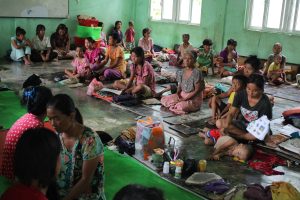The ongoing war in Myanmar’s Rakhine State between the Myanmar military and the Arakan Army has displaced hundreds of thousands of people from all communities that inhabit the region. The situation is similar to other parts of the country where the civil war has compelled people to leave their homes and relocate to camps and hideouts inside the country and the neighboring countries of India and Thailand.
Rakhine State stands next only to Myanmar’s Sagaing Region in terms of the number of people who were displaced after the February 2021 military coup. According to data released by the United Nations High Commissioner for Refugees (UNHCR) on July 29, of a total of 3,270,400 internally displaced persons (IDPs) in all of Myanmar, 502,300 were from Rakhine State.
According to data compiled by the Humanitarian and Development Coordination Office (HDCO) of the United League of Arakan (ULA), the political front of the Arakan Army, as of May 20, there were 572,300 IDPs in Rakhine State and Paletwa in Chin State, including 349,190 women, with Buthidaung Township topping the list at 142,379 followed by Pauktaw at 119,053 and Maungdaw at 72,950 IDPs.
Rakhine State has witnessed several waves of displacement over the decades beginning with the Myanmar military’s repeated offensives against the Rohingya Muslims, especially in 2012 and 2017, and the ongoing war between the Arakan Army and the military.
Media reports in 2020 pegged the number of IDPs from Rakhine State at around 200,000, most of whom relocated from the northern region of the state to safer areas. The figure released by UNHCR includes 155,511 “stateless persons,” who are Rohingya Muslims evicted from their villages after the military launched a series of operations against the community over the past several years. Apart from the conflict, Cyclone Mocha had left 267,000 people in need of shelter last year, according to UNHCR.
IDPs are scattered across most of the 17 townships in Rakhine State and also in Paletwa in the contiguous Chin State, which is under the control of the Arakan Army. Besides camps, IDPs are taking shelter in monasteries, mosques, and in the homes of their relatives. The displaced include all the communities inhabiting the region — the Khumi, Chin, Chakma, Mro, Rakhine Buddhists, and Rohingya Muslims.
I visited southern Chin State and Rakhine State on a covert assignment between June 13 and July 6 this year. Among the places I visited was a village where IDPs are being sheltered and four camps — one in Ponnagyun Township and three in Buthidaung Township — have been set up.
ULA functionaries told The Diplomat that almost 70 percent of the IDPs comprise Rakhine Buddhists followed by Rohingya Muslims, who make up about 25 percent of the total displaced population.
The IDPs need shelter, food, and medicines. According to Phroe Zaw, deputy director of the HDCO in Regional Office No. 2, so far, the needs of just 30-40 percent of all IDPs have been met by rehabilitation efforts of village committees and the ULA’s HDCO department.
“In some camps, we have provided only food and only shelter material in others,” he told The Diplomat in an interview at Rathedaung Township on June 28, adding that people “are in urgent need of medicines, especially for malaria and diseases that afflict people during the rainy season. Poor communication is standing in the way of aid and rehabilitation efforts.”
The Myanmar military has not allowed global humanitarian agencies to operate and provide aid in the areas liberated by the Arakan Army.


















































